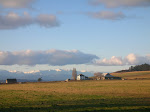I have learned (or at least I keep trying to tell myself) that it is best to tackle "preservation" projects bit by by through the summer, preserving the crops as they come on. Otherwise it can be a bit overwhelming. But the sooner I can start "putting up the bounty" the better. And around here, one of the first major preservation projects I get into of the spring/summer is pickling garlic scapes.
Garlic scapes, which we talk a lot about this time of year, are the seed scapes from hard neck garlic. They are oddly (and interestingly) shaped with a mild garlic flavor and great texture. Think asparagus, only garlicky and more curlique. They are great chopped raw, grilled, baked and pickled. I really, really like them pickled. They are crunchy and garlicky and fabulous! If you keep the scape whole (rather than cut into pieces, which you can also do when pickling) then the scape itself is a work of beauty, a perfect addition on an antipasto plate or, even better, topping off a Bloody Mary!
So how to pickle garlic scapes? Well they are very easy and if you haven't pickled before they are a great project to start with - it's hard to mess them up really. And...to encourage the pickler in us all, we are having a great deal on 1 lb bags of garlic scapes at the Coupeville and Bayview markets today - just $5 for one lb of scapes!
Of course, you need a few recipes so here goes...
A pickled scape posting from a blogger that goes into great detail about pickling scapes with a simple recipe - http://www.canningacrossamerica.com/2011/06/20/garlic-scape-pickle-party/
Or...we are privileged to have received Chef Joe Scott's, of the Oystercatcher in Coupeville, recipe for pickling garlic scapes.
Oystercatcher’s Quick Pickled Garlic Scapes
Courtesy of Joe Scott, Chef at Oystercatcher in Coupeville, WA
· Garlic scapes, 1 lb, chopped into 1 inch pieces, or left whole with ends trimmed. (If left whole the scapes should be left to pickle for a week before use).
· Champagne vinegar (or white wine vinegar)
· Rice Vinegar
· Dash of salt
· Sugar to taste
· Pinch of whole fennel seed
You will need equal parts of the vinegar, how much depends on how much you are going to pickle. Chop (or trim) scapes and pack clean mason jars. Boil equal parts of both vinegars, add sugar and salt to taste. Sugar should balance the acidity of the vinegar. How sweet – versus tart – you make it is a personal preference depending on how you like your pickles. When boiling, pour over scapes. Add a pinch of whole fennel seed. Seal lid. These pickles are ready in 4 hours. If you prefer to keep the scape whole (which gives you a very cool shape on a plate), you should plan to let the pickles sit for at least a week (or more) so they absorb the pickling juices. By chopping the scapes you provide more surface area to absorb the pickling juices quickly.
So happy pickling! And let me know how they turn out.
And of course...we have much much more to bring to the Coupeville and Bayview farmer's markets today including...
From Willowood Farm:
* Mesclun mix (aka spring mix)
* Head Lettuce
* Arugula bags
* Braising Green bunches
* Japanese Salad Turnips
* Baby Pac Choi
* Raab bunches
* French Breakfast radishes
* Fresh Garlic
* New Potatoes
* Walla Walla Salad Onions
* Peregion Dry Beans
* Kohlrabi
* Basil
* Peregion Dry Beans
From our friends at Prairie Bottom Farm:
* Lettuce Mix
* Spinach
* Baby Beet Bunches
* Chard Bunches
* Green Onions
* Endive
* Cress
* Baby Carrot bunches
From Emmer bags from Ebey Road Farm.
Lots of food today and a beautiful day to boot. Hope to see you at market!













